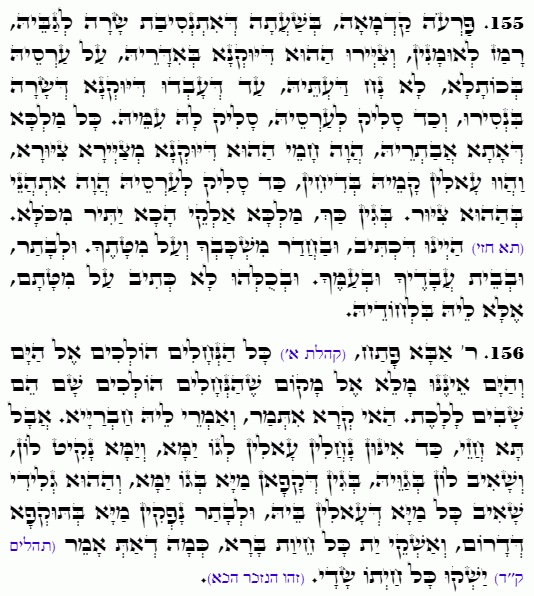Daily Zohar # 4762 – Vaera – All the rivers run into the sea
Daily Zohar 4762

Hebrew translation:
156. רַבִּי אַבָּא פָּתַח, (קהלת א) כָּל הַנְּחָלִים הֹלְכִים אֶל הַיָּם וְהַיָּם אֵינֶנּוּ מָלֵא אֶל מָקוֹם שֶׁהַנְּחָלִים הֹלְכִים שָׁם הֵם שָׁבִים לָלֶכֶת. פָּסוּק זֶה נֶאֱמַר וְאָמְרוּ אוֹתוֹ הַחֲבֵרִים, אֲבָל בֹּא רְאֵה, כְּשֶׁאוֹתָם נְחָלִים נִכְנָסִים לְתוֹךְ הַיָּם, וְהַיָּם לוֹקֵחַ אוֹתָם וְשׁוֹאֵב אוֹתָם לְתוֹכוֹ בִּשְׁבִיל שֶׁקּוֹפְאִים הַמַּיִם בְּתוֹךְ הַיָּם, וְאוֹתוֹ הַקֶּרַח שׁוֹאֵב אֶת הַמַּיִם שֶׁנִּכְנָס בּוֹ, וְאַחַר כָּךְ יוֹצְאִים הַמַּיִם בְּתֹקֶף שֶׁל הַדָּרוֹם, וּמַשְׁקֶה אֶת כָּל חַיּוֹת הַשָּׂדֶה, כְּמוֹ שֶׁנֶּאֱמַר (תהלים קד) יַשְׁקוּ כָּל חַיְתוֹ שָׂדָי.
.
Zohar Vaera
Continued from previous DZ
#155
The first Pharaoh, at the time when Sarah was taken to him, had her likeness depicted by artisans and painted on the wall of his chamber near his bed. Yet, this did not satisfy him until they created a figure of Sarah on a tablet, which he would bring with him to his bed. Every king who came after him would see this image depicted in the artwork. Jokers would go before him, and he would derive pleasure from that image when he ascended to his bed.
Because of this, the king (Pharaoh), during the plagues, was struck more severely than all others. This is why it is written: “וּבַחֲדַר מִשְׁכָּבְךָ וְעַל מִטָּתֶךָ וְאַחַר כֵּן בְּבֵית עֲבָדֶיךָ וּבְעַמְּךָ”—”And in your bedroom, and on your bed; and afterward in the house of your servants and among your people” (Exodus 8:3). Notice that concerning him alone, it mentions his bed specifically, whereas for others, it does not mention ‘their bed,’ but only the house and the people.
Notes:
The Zohar connects Pharaoh’s punishment during the plagues to his misuse of Sarah’s image, emphasizing the principle of measure-for-measure justice and illustrating how sins can resonate across generations.
#156
Rabbi Aba opened: “כָּל הַנְּחָלִים הֹלְכִים אֶל הַיָּם וְהַיָּם אֵינֶנּוּ מָלֵא אֶל מָקוֹם שֶׁהַנְּחָלִים הֹלְכִים שָׁם הֵם שָׁבִים לָלֶכֶת” “All the rivers run into the sea, Yet the sea is not full; To the place from which the rivers come, There they return again.” (Ecclesiastes 1:7). This verse has been explained, and the friends have elaborated on it. But come and see: When these rivers, which are the lights of Zeir Anpin (Z “A), flow into the sea, which is Malchut, the sea receives them and absorbs them into itself. This is because the waters freeze within the sea, and this ice draws all the waters into itself. Afterward, the waters flow forth through the strength of the south, meaning Chessed from the right side, and water all the beasts of the field, as it is written: “יַשְׁקוּ כָּל חַיְתוֹ שָׂדָי” “They give drink to every beast of the field” (Psalms 104:11).
Explanation: Initially, Malchut, referred to as the sea, receives illumination only from the left side. At this stage, her stature equals that of Z “A, as she receives the illumination of Chokmah, which constitutes the upper three Sefirot. However, this Light lacks Chassadim, and ChoKmah cannot shine without Chassadim. Thus, Malchut is described as a “ים הקפוא” “frozen sea,” where its Light is frozen and unable to illuminate.
Later, the middle line, which brings together the left and right sides, intervenes. It strengthens the right side (Chessed) over the left (Gevurah), allowing the right side to flow Chassadim into the left. With the illumination of Chokmah clothed in Chassadim, the “ice” in the sea melts, and Malchut becomes a source of life, watering and sustaining all worlds.
Notes:
The Zohar illustrates the process of illumination and balance within the Sefirot, where Malchut transitions from a state of “frozen sea” (receptive but non-illuminating) to a source of life and abundance through the harmonization of left and right by the middle line. This balance allows the Light to flow to all creation.
{||

 Previous: Vaera
Previous: Vaera

